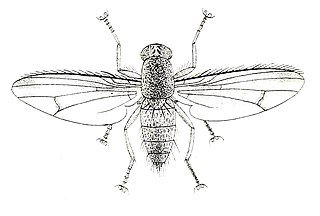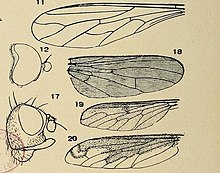
The Tephritidae are one of two fly families referred to as fruit flies, the other family being the Drosophilidae. The family Tephritidae does not include the biological model organisms of the genus Drosophila, which is often called the "common fruit fly". Nearly 5,000 described species of tephritid fruit fly are categorized in almost 500 genera of the Tephritidae. Description, recategorization, and genetic analyses are constantly changing the taxonomy of this family. To distinguish them from the Drosophilidae, the Tephritidae are sometimes called peacock flies, in reference to their elaborate and colorful markings. The name comes from the Greek τεφρος, tephros, meaning "ash grey". They are found in all the biogeographic realms.

The Lonchopteridae are a family of small (2–5 mm), slender, yellow to brownish-black Diptera, occurring all over the world. Their common name refers to their pointed wings, which have a distinct venation. Many are parthenogenic; males are very rare, however, at least in North American species, and have a somewhat different venation than do the females.

The Micropezidae are a moderate-sized family of acalyptrate muscoid flies in the insect order Diptera, comprising about 500 species in about 50 genera and five subfamilies worldwide,. They are most diverse in tropical and subtropical habitats, especially in the Neotropical Region.

The Psilidae are family of flies. Commonly called the rust flies, at least 38 species are in four genera. The carrot fly is a member of this group. They are found mainly in the Holarctic.

Dolichopodidae, the long-legged flies, are a large, cosmopolitan family of true flies with more than 7,000 described species in about 230 genera. The genus Dolichopus is the most speciose, with some 600 species.

The Limoniinae are a paraphyletic assemblage of genera within the crane flies, Tipulidae, although they can usually be distinguished by the way the wings are held at rest. Limoniines usually hold/fold the wings along the back of the body, whereas other tipulids usually hold them out at right angles. Snow flies such as Chionea scita have no wings at all. Limoniines are also usually smaller than other tipulids, with some exceptions. Limoniinae are a very large assemblage with nearly 10,500 described species in 133 genera, and were historically treated as a subfamily, but their classification is in flux; numerous authors recently treated the group at the rank of family, but subsequent phylogenetic analyses revealed that the remaining groups of tipulids render the group paraphyletic. These flies are found in damp places throughout the world, and many species form dense swarms in suitable habitats.

The Anisopodidae are a small cosmopolitan family of gnat-like flies known as wood gnats or window-gnats, with 154 described extant species in 15 genera, and several described fossil taxa. Some species are saprophagous or fungivorous. They are mostly small to medium-sized flies, except the genera Olbiogaster and Lobogaster, which are large with bizarrely spatulated abdomens. Their phylogenetic placement is controversial. They have been proposed to be the sister group to the higher flies, the Brachycera. Some authors consider this group to be four distinct families – Anisopodidae, Mycetobiidae, Olbiogastridae, and Valeseguyidae.

The Lonchaeidae are a family of acalyptrate flies commonly known as lance flies. About 500 described species are placed into 9 genera. These are generally small but robustly built flies with blue-black or metallic bodies. They are found, mainly in wooded areas, throughout the world with the exception of polar regions and New Zealand.

The Chamaemyiidae are a small family of acalyptrate flies with less than 200 species described worldwide. The larvae of these small flies are active and predatory and are often used for biological control of aphids, scale insects, and similar pests. Chamaemyiid fossils are poorly represented in amber deposits, but a few examples are known from the Eocene epoch onwards.

Opomyzidae is a family of acalyptrate Diptera. They are generally small, slender, yellow, brown or black coloured flies. The larval food plants are grasses, including cereal crops, the adults are mainly found in open habitats. Some species being agricultural pests.

The Curtotonidae or quasimodo flies are a small family of small grey to dark brown humpbacked flies (Diptera) with a worldwide distribution, but with very few species in the Nearctic, Australasian/Oceanian, and Palaearctic regions. Most members of the family are found in tropical to subtropical latitudes in Africa and the Neotropics. Many remain undescribed in collections, since little work on the family has been done since the 1930s.

Asteiidae is a small but widespread family of acalyptrate flies or Diptera. About 130 species in 10 genera have been described worldwide. They are rarely collected.

The Coelopidae or kelp flies are a family of Acalyptratae flies, they are sometimes also called seaweed flies, though both terms are used for a number of seashore Diptera. Fewer than 40 species occur worldwide. The family is found in temperate areas, with species occurring in the southern Afrotropical, Holarctic, and Australasian regions.

Diastatidae are a family of flies, and are in the order Diptera. They occur primarily in the Holarctic Region, but several species are known from the Oriental, Neotropical, and Australasian regions. Members of the family number over 20 described species in three genera. There is an additional fossil genus.

Platypezidae is a family of true flies of the superfamily Platypezoidea. The more than 250 species are found worldwide primarily in woodland habitats. A common name is flat-footed flies, but this is also used for the closely related Opetiidae which were included in the Platypezidae in former times.
Aulacigastridae is a very small family of flies known as sap flies. The family Stenomicridae used to be included within this family, but was moved by Papp in 1984. They are found in all the Ecoregions.
Dipteran morphology differs in some significant ways from the broader morphology of insects. The Diptera is a very large and diverse order of mostly small to medium-sized insects. They have prominent compound eyes on a mobile head, and one pair of functional, membraneous wings, which are attached to a complex mesothorax. The second pair of wings, on the metathorax, are reduced to halteres. The order's fundamental peculiarity is its remarkable specialization in terms of wing shape and the morpho-anatomical adaptation of the thorax – features which lend particular agility to its flying forms. The filiform, stylate or aristate antennae correlate with the Nematocera, Brachycera and Cyclorrhapha taxa respectively. It displays substantial morphological uniformity in lower taxa, especially at the level of genus or species. The configuration of integumental bristles is of fundamental importance in their taxonomy, as is wing venation. It displays a complete metamorphosis, or holometabolous development. The larvae are legless, and have head capsules with mandibulate mouthparts in the Nematocera. The larvae of "higher flies" (Brachycera) are however headless and wormlike, and display only three instars. Pupae are obtect in the Nematocera, or coarcate in Brachycera.

Periscelididae is a family of flies.
Teratomyzidae are a family of small flies found mainly in the southern continents and are absent from Europe, North America, and Africa. They are specialist feeders on fern fronds. There are about thirty five species. They appear somewhat like anthomyzids, the body is elongated and appear dusty coated. The antenna are somewhat as in Aulacigastridae and Neminidae. The wing is distinctive in its venation, the costa is weake after the humeral crossvein and broken before vein 1 with an elongate dorsal bristle before the break. Vein 1 short and joins costa within quarter length of the wing. Vein 6 terminates beyond discal crossvein.
















